Assessing the Impact of Deficit Irrigation and Kaolin Application on Almond Orchards: Statistical Relationships with Crop Yields and Spectral Vegetation Indices
Abstract
1. Introduction
2. Materials and Methods
2.1. Case Study and Field Trials
2.2. Remotely Sensed Image Acquisition and Processing
2.3. Multivariate Statistical Analysis
- Treatments—descriptive statistics summarising their relationship with crop yields are presented. Then, an analysis of variance (ANOVA) was performed to compare means of the various treatments and assess significant differences among them, as well as multiple comparisons between treatment pairs using the Tukey test.
- Predictions—this component was designed for developing a supervised machine learning approach, when using the OLS and RF regression models to predict crop yields in each treatment based on selected spectral features (VI).
- Evaluation—the effectiveness of the crop yield predictive models was evaluated through the following statistical metrics: coefficient of determination (R2), mean absolute error (MAE), and root mean square error (RMSE).
2.3.1. Comparison of Treatments
- Analysis of variance (ANOVA)—one-way ANOVA was conducted to examine the almond production means of all treatments. Significant differences (p-value ≤ 0.05) are found if at least one mean is statistically different. In that case, the influence of the three targeted factors and their interactions (Table 1) on the almond production was also explored (three-way ANOVA). This multifactorial analysis enables us to understand not only the individual effect of each factor, but also how these factors interact with each other [72].
- Tukey’s Honestly Significant Difference (HSD) test—after ANOVA application, as there were significant overall differences among treatment means, multiple comparisons between pairs of treatments were performed to identify which pairs differ statistically. For each pairwise comparison, this post hoc test also provides a 95% confidence interval of the mean difference, representing the range within which the true difference in means is likely to be found. When the confidence interval includes zero, the difference between two treatments is not statistically significant [72].
2.3.2. Integration of Spectral Features to Predict Crop Yields
- Feature selection
- Regression models
- Parametric OLS model—This is employed in linear regression to estimate the relationship between explanatory variables (VI) and a dependent variable (crop yields) by minimising the sum of squared errors. It provides regression coefficients, and evaluates the statistical significance and model fit under linearity, independence, and homoscedasticity assumptions, and normal error distribution [74].
- Nonparametric RF model—This is based on an ensemble learning algorithm that builds multiple decision trees on different subsets (random samples) from the original data and combines their outputs to obtain accurate predictions. In addition, it reduces the risk of overfitting by averaging the results (regression) or by using majority voting (feature importance ranking), effectively handling the non-linearity of the predictors [75].
2.3.3. Modelling Evaluation
3. Results and Discussion
3.1. Influence of Treatments on Crop Yields
- In most pairwise comparisons, the cultivar factor contributed incisively to significant yield differences, as the mean difference did not contain zero;
- Differences tend to be negative, essentially due to the higher production records for the cv. Constantí, and in V100 compared to V100/35;
- The closest combinations to zero (central value) occurred mainly when the kaolin application was the differentiating factor. Zero in the error bars (i.e., confidence intervals) represents a probable absence of differences between the two treatments;
- In most cases, mean differences in in-shell almond production showed a relatively similar pattern to that of kernel production, although with values differing in magnitude.
3.2. Crop Yield Predictions and Evaluation
- The UAV flight date, from which the analysed VI were produced, shows considerable differences with regard to the selected features and their weight in estimating crop yields for each treatment. This happens because distinct VI can respond differently depending on the crop’s physiological and phenological conditions, thus altering their relationship with the dependent variable (almond production);
- Within the treatments, reduced model complexity, i.e., with fewer explanatory variables (VI), was found in C100 + K and V100 for 3 August 2021, and in C100/35, C100/35+K, V100, and V100/35 for 30 August 2021. Thereby, simpler and more interpretable models were generated by reducing the risk of overfitting;
- When relating the VI with the treatments, the results are not so conclusive, as the crop response variability to the VI depends largely on how the dataset is trained (i.e., by combining decision trees). However, there is a certain preponderance attributed to the GNVI and NDRE, most likely due to the fact that these saturate later than NDVI and are, therefore, more sensitive to canopy density and leaf chlorophyll variations. These UAV-based VI were also emphasised by Killeen et al. and Ramos et al. [28,29] when predicting maize yields using an RF ranking approach.
- Treatment—the most significant deviations (higher MAE and RMSE) and lower R2 are associated with the C100/35, V100/35, and V100/35+K treatments, largely explained by the high data dispersion. For C100/35, larger deviations are also in line with the higher almond yields. By comparing the models, as previously mentioned, the RF algorithm contributed greatly to improved predictions. The exception is the C100+K treatment, where the OLS model generated more accurate results, indicating the existence of a predominantly linear and simple relationship among the variables. In the scenario with all treatments, the absolute and squared mean errors (MAE and RMSE) tend to be higher, reducing the variance explained by the models (R2).
- UAV flight date—in most treatments, lower average errors and a better correlation were found when dealing with special features (VI) from 30 August 2021. It therefore means that the closest spectral signature to the harvest may be a decisive factor for improving the performance of the regression models.
- Production type—when crossing plots a and b, a similar statistical pattern is observed, as the in-shell almond production is directly proportional to the extracted almond kernel. For this reason, part of the statistical analysis for almond kernel production is presented as auxiliary information (Appendix B).
4. Conclusions
Author Contributions
Funding
Institutional Review Board Statement
Informed Consent Statement
Data Availability Statement
Conflicts of Interest
Appendix A
| Treatments | UAV Image Dates | Production Types | Models | Regression Results * | Statistical Metrics | ||
|---|---|---|---|---|---|---|---|
| R2 | MAE (kg/tree) | RMSE (kg/tree) | |||||
| C100 | 3 August 2021 | Shell | OLS | y = −10.57 + 126.44 GNDVI − 122,781.49 NDVI + 105,766.51 OSAVI | 0.72 | 0.56 | 0.61 |
| RF | NDRE: 0.31, LAI_SAVI: 0.29, VARI: 0.18, OSAVI: 0.08, SR: 0.08, GNDVI: 0.06 | 0.88 | 0.33 | 0.41 | |||
| Kernel | OLS | y = −2.54 + 30.41 GNDVI − 29,529.22 NDVI + 25,437.08 OSAVI | 0.72 | 0.14 | 0.15 | ||
| RF | NDRE: 0.32, LAI_SAVI: 0.28, VARI: 0.19, GNDVI: 0.08, OSAVI: 0.08, SR: 0.05 | 0.88 | 0.08 | 0.10 | |||
| 30 August 2021 | Shell | OLS | y = 45.54 + 108.22 EVI − 202,075.03 NDVI + 173,964.57 OSAVI − 74.41 VARI | 0.79 | 0.46 | 0.51 | |
| RF | LAI_SAVI: 0.38, SR: 0.33, NDRE: 0.16, VARI: 0.13 | 0.89 | 0.33 | 0.38 | |||
| Kernel | OLS | y = 10.95 + 26.02 EVI − 48,609.33 NDVI + 41,847.35 OSAVI − 17.89 VARI | 0.79 | 0.11 | 0.12 | ||
| RF | LAI_SAVI: 0.35, SR: 0.27, NDRE: 0.16, VARI: 0.09, GNDVI: 0.06, EVI: 0.04, OSAVI: 0.03 | 0.88 | 0.08 | 0.09 | |||
| C100+K | 3 August 2021 | Shell | OLS | y = −30.93 + 20.32 EVI + 116.74 GNDVI − 1.97 NDRE + 1798.08 NDVI − 1637.73 OSAVI + 1.62 SR − 84.25 VARI | 0.98 | 0.09 | 0.12 |
| RF | NDRE: 0.55, SR: 0.45 | 0.87 | 0.23 | 0.27 | |||
| Kernel | OLS | y = −7.40 + 4.86 EVI + 27.94 GNDVI − 0.47 NDRE + 424.82 NDVI − 387.20 OSAVI + 0.39 SR − 20.17 VARI | 0.98 | 0.02 | 0.03 | ||
| RF | NDRE: 0.50, GNDVI: 0.50 | 0.88 | 0.05 | 0.06 | |||
| 30 August 2021 | Shell | OLS | y = 0.36 + 14.01 EVI − 64.50 GNDVI + 107.17 NDRE + 347,395.55 NDVI − 299,485.12 OSAVI − 83.50 VARI | 0.94 | 0.15 | 0.19 | |
| RF | NDRE: 0.28, EVI: 0.20, GNDVI: 0.14, VARI: 0.11, LAI_SAVI: 0.09, NDVI: 0.07, OSAVI: 0.06, SR: 0.05 | 0.87 | 0.25 | 0.27 | |||
| Kernel | OLS | y = 0.09 + 3.35 EVI − 15.44 GNDVI + 25.65 NDRE + 83,166.21 NDVI − 71,696.49 OSAVI − 19.98 VARI | 0.94 | 0.04 | 0.04 | ||
| RF | NDRE: 0.27, EVI: 0.22, GNDVI: 0.14, VARI: 0.11, LAI_SAVI: 0.09, NDVI: 0.07, OSAVI: 0.06, SR: 0.04 | 0.87 | 0.06 | 0.06 | |||
| C100/35 | 3 August 2021 | Shell | OLS | y = −6.47 + 26.41 GNDVI − 1,267,243.94 NDVI + 1,092,458.64 OSAVI | 0.25 | 0.87 | 0.97 |
| RF | LAI_SAVI: 0.24, NDRE: 0.18, VARI: 0.18, SR: 0.16, GNDVI: 0.14, EVI: 0.10 | 0.79 | 0.42 | 0.51 | |||
| Kernel | OLS | y = −1.50 + 6.12 GNDVI − 293,566.27 NDVI + 253,075.99 OSAVI | 0.25 | 0.20 | 0.22 | ||
| RF | LAI_SAVI: 0.24, VARI: 0.17, NDRE: 0.15, OSAVI: 0.10, GNDVI: 0.10, EVI: 0.08, NDVI: 0.08, SR: 0.08 | 0.80 | 0.09 | 0.12 | |||
| 30 August 2021 | Shell | OLS | y = 14.96 + 387.99 GNDVI + 1,749,627.25 NDVI − 1,508,663.44 OSAVI + 194.07 VARI | 0.38 | 0.72 | 0.85 | |
| RF | LAI_SAVI: 0.45, NDRE: 0.35, VARI: 0.20 | 0.87 | 0.31 | 0.39 | |||
| Kernel | OLS | y = 3.46 + 89.88 GNDVI + 405,305.82 NDVI − 349,485.91 OSAVI + 44.96 VARI | 0.38 | 0.17 | 0.20 | ||
| RF | LAI_SAVI: 0.48, NDRE: 0.35, VARI: 0.17 | 0.87 | 0.07 | 0.09 | |||
| C100/35+K | 3 August 2021 | Shell | OLS | y = 5.29 − 79.55 GNDVI − 1,493,934.44 NDVI + 1,287,952.71 OSAVI | 0.30 | 0.57 | 0.76 |
| RF | LAI_SAVI: 0.25, VARI: 0.24, EVI: 0.14, GNDVI: 0.09, OSAVI: 0.09, SR: 0.08, NDVI: 0.06, NDRE: 0.05 | 0.80 | 0.32 | 0.41 | |||
| Kernel | OLS | y = 1.27 − 19.09 GNDVI − 358,502.35 NDVI + 309,072.51 OSAVI | 0.30 | 0.14 | 0.18 | ||
| RF | LAI_SAVI: 0.26, VARI: 0.24, SR: 0.14, EVI: 0.13, OSAVI: 0.12, GNDVI: 0.11 | 0.79 | 0.08 | 0.10 | |||
| 30 August 2021 | Shell | OLS | y = 1.52 + 69.10 NDRE + 1,233,352.10 NDVI − 1,063,263.57 OSAVI − 46.16 VARI | 0.73 | 0.38 | 0.47 | |
| RF | EVI: 0.38, SR: 0.36, VARI: 0.26 | 0.82 | 0.35 | 0.38 | |||
| Kernel | OLS | y = 0.37 + 16.58 NDRE + 295,951.23 NDVI − 255,137.33 OSAVI − 11.08 VARI | 0.73 | 0.09 | 0.11 | ||
| RF | EVI: 0.37, SR: 0.36, VARI: 0.27 | 0.83 | 0.08 | 0.09 | |||
| V100 | 3 August 2021 | Shell | OLS | y = −49.88 + 117.80 GNDVI + 335,659.77 NDVI − 289,393.31 OSAVI | 0.81 | 0.42 | 0.48 |
| RF | GNDVI: 0.53, NDRE: 0.47 | 0.91 | 0.27 | 0.34 | |||
| Kernel | OLS | y = −13.87 + 32.75 GNDVI + 93,320.44 NDVI − 80,457.40 OSAVI | 0.81 | 0.12 | 0.13 | ||
| RF | GNDVI: 0.46, NDRE: 0.31, LAI_SAVI: 0.23 | 0.90 | 0.08 | 0.10 | |||
| 30 August 2021 | Shell | OLS | y = 3.25 + 107.75 NDRE − 447,275.43 NDVI + 385,542.81 OSAVI | 0.78 | 0.37 | 0.52 | |
| RF | NDRE: 0.56, GNDVI: 0.44 | 0.92 | 0.26 | 0.32 | |||
| Kernel | OLS | y = 0.90 + 29.96 NDRE − 124,364.64 NDVI + 107,199.92 OSAVI | 0.92 | 0.07 | 0.09 | ||
| RF | NDRE: 0.56, GNDVI: 0.44 | 0.92 | 0.07 | 0.09 | |||
| V100+K | 3 August 2021 | Shell | OLS | y = −8.22 − 54.82 GNDVI + 405,592.38 NDVI − 349,590.51 OSAVI | 0.53 | 0.52 | 0.63 |
| RF | EVI: 0.51, LAI_SAVI: 0.16, SR: 0.11, VARI: 0.09, OSAVI: 0.05, GNDVI: 0.05, NDRE: 0.03 | 0.90 | 0.21 | 0.28 | |||
| Kernel | OLS | y = −2.25 − 15.02 GNDVI + 111,090.30 NDVI − 95,751.59 OSAVI | 0.53 | 0.14 | 0.17 | ||
| RF | EVI: 0.51, LAI_SAVI: 0.16, SR: 0.11, VARI: 0.09, OSAVI: 0.05, GNDVI: 0.04, NDRE: 0.04 | 0.90 | 0.06 | 0.08 | |||
| 30 August 2021 | Shell | OLS | y = −64.11 + 21.82 EVI + 349.00 GNDVI − 248.17 NDRE + 1,747,987.09 NDVI − 1,506,988.99 OSAVI − 5.81 SR + 58.25 VARI | 0.86 | 0.28 | 0.34 | |
| RF | EVI: 0.35, LAI_SAVI: 0.30, SR: 0.13, VARI: 0.13, OSAVI: 0.09 | 0.88 | 0.22 | 0.32 | |||
| Kernel | OLS | y = −17.56 + 5.98 EVI + 95.59 GNDVI − 67.97 NDRE + 478,770.09 NDVI − 412,761.20 OSAVI − 1.59 SR + 15.96 VARI | 0.86 | 0.08 | 0.09 | ||
| RF | EVI: 0.38, LAI_SAVI: 0.28, VARI: 0.13, SR: 0.13, OSAVI: 0.08 | 0.88 | 0.06 | 0.09 | |||
| V100/35 | 3 August 2021 | Shell | OLS | y = 11.14 − 21.55 GNDVI − 801,428.62 NDVI + 690,903.93 OSAVI | 0.39 | 0.61 | 0.80 |
| RF | VARI: 0.22, EVI: 0.20, NDRE: 0.20, LAI_SAVI: 0.14, OSAVI: 0.09, GNDVI: 0.08, NDVI: 0.07 | 0.87 | 0.32 | 0.38 | |||
| Kernel | OLS | y = 2.90 − 5.60 GNDVI − 208,256.50 NDVI + 179,535.93 OSAVI | 0.39 | 0.16 | 0.21 | ||
| RF | VARI: 0.22, EVI: 0.20, NDRE: 0.19, LAI_SAVI: 0.15, OSAVI: 0.09, GNDVI: 0.08, NDVI: 0.07 | 0.87 | 0.08 | 0.10 | |||
| 30 August 2021 | Shell | OLS | y = −13.91 + 93.55 EVI − 178.85 GNDVI − 2,348,816.12 NDVI + 2,024,891.02 OSAVI − 193.23 VARI | 0.64 | 0.48 | 0.60 | |
| RF | LAI_SAVI: 0.58, GNDVI: 0.42 | 0.84 | 0.33 | 0.40 | |||
| Kernel | OLS | y = −3.62 + 24.31 EVI − 46.48 GNDVI − 610,350.63 NDVI + 526,177.21 OSAVI − 50.21 VARI | 0.64 | 0.13 | 0.16 | ||
| RF | LAI_SAVI: 0.58, GNDVI: 0.42 | 0.84 | 0.08 | 0.10 | |||
| V100/35+K | 3 August 2021 | Shell | OLS | y = 6.89 + 17.94 GNDVI + 848,857.17 NDVI − 731,796.22 OSAVI | 0.14 | 0.76 | 1.01 |
| RF | NDRE: 0.21, SR: 0.21, EVI: 0.17, LAI_SAVI: 0.12, GNDVI: 0.12, OSAVI: 0.09, NDVI: 0.08 | 0.84 | 0.36 | 0.43 | |||
| Kernel | OLS | y = 1.79 + 4.67 GNDVI + 221,130.09 NDVI − 190,635.33 OSAVI | 0.14 | 0.20 | 0.26 | ||
| RF | NDRE: 0.22, EVI: 0.20, SR: 0.19, OSAVI: 0.15, GNDVI: 0.14, LAI_SAVI: 0.10 | 0.83 | 0.10 | 0.12 | |||
| 30 August 2021 | Shell | OLS | y = −0.79 + 28.18 GNDVI + 810,480.85 NDVI − 698,711.90 OSAVI | 0.06 | 0.81 | 1.06 | |
| RF | SR: 0.24, EVI: 0.19, VARI: 0.18, NDVI: 0.15, OSAVI: 0.10, GNDVI: 0.07, LAI_SAVI: 0.07 | 0.81 | 0.41 | 0.47 | |||
| Kernel | OLS | y = −0.21 + 7.34 GNDVI + 211,147.69 NDVI − 182,029.47 OSAVI | 0.06 | 0.21 | 0.28 | ||
| RF | SR: 0.23, EVI: 0.20, VARI: 0.17, NDVI: 0.14, OSAVI: 0.10, GNDVI: 0.08, LAI_SAVI: 0.08 | 0.80 | 0.11 | 0.13 | |||
| All treatments | 3 August 2021 | Shell | OLS | y = −35.89 + 12.25 EVI + 115.74 GNDVI − 71.92 NDRE − 532,134.94 NDVI + 458,715.31 OSAVI − 35.65 VARI | 0.41 | 0.89 | 1.14 |
| RF | GNDVI: 0.24, VARI: 0.19, LAI_SAVI: 0.14, NDRE: 0.11, EVI: 0.11, SR: 0.10, NDVI: 0.06, OSAVI: 0.05 | 0.67 | 0.70 | 0.85 | |||
| Kernel | OLS | y = −6.48 + 2.23 EVI + 20.15 GNDVI − 9.67 NDRE − 80,420.58 NDVI + 69,323.63 OSAVI − 6.59 VARI | 0.33 | 0.21 | 0.27 | ||
| RF | GNDVI: 0.25, NDRE: 0.17, LAI_SAVI: 0.17, VARI: 0.13, SR: 0.12, EVI: 0.09, OSAVI: 0.07 | 0.67 | 0.15 | 0.19 | |||
| 30 August 2021 | Shell | OLS | y = −17.01 + 12.33 EVI + 109.79 GNDVI − 21.26 NDRE + 76,670.78 NDVI − 66,166.38 OSAVI − 18.71 VARI | 0.47 | 0.82 | 1.08 | |
| RF | VARI: 0.50, EVI: 0.14, GNDVI: 0.13, NDRE: 0.12, LAI_SAVI: 0.11 | 0.79 | 0.56 | 0.68 | |||
| Kernel | OLS | y = −2.87 + 2.12 EVI + 24.06 GNDVI + 0.72 NDRE − 11,190.95 NDVI + 9629.70 OSAVI − 1.27 VARI | 0.40 | 0.19 | 0.25 | ||
| RF | VARI: 0.37, GNDVI: 0.20, NDRE: 0.18, EVI: 0.16, LAI_SAVI: 0.09 | 0.77 | 0.13 | 0.16 | |||
Appendix B


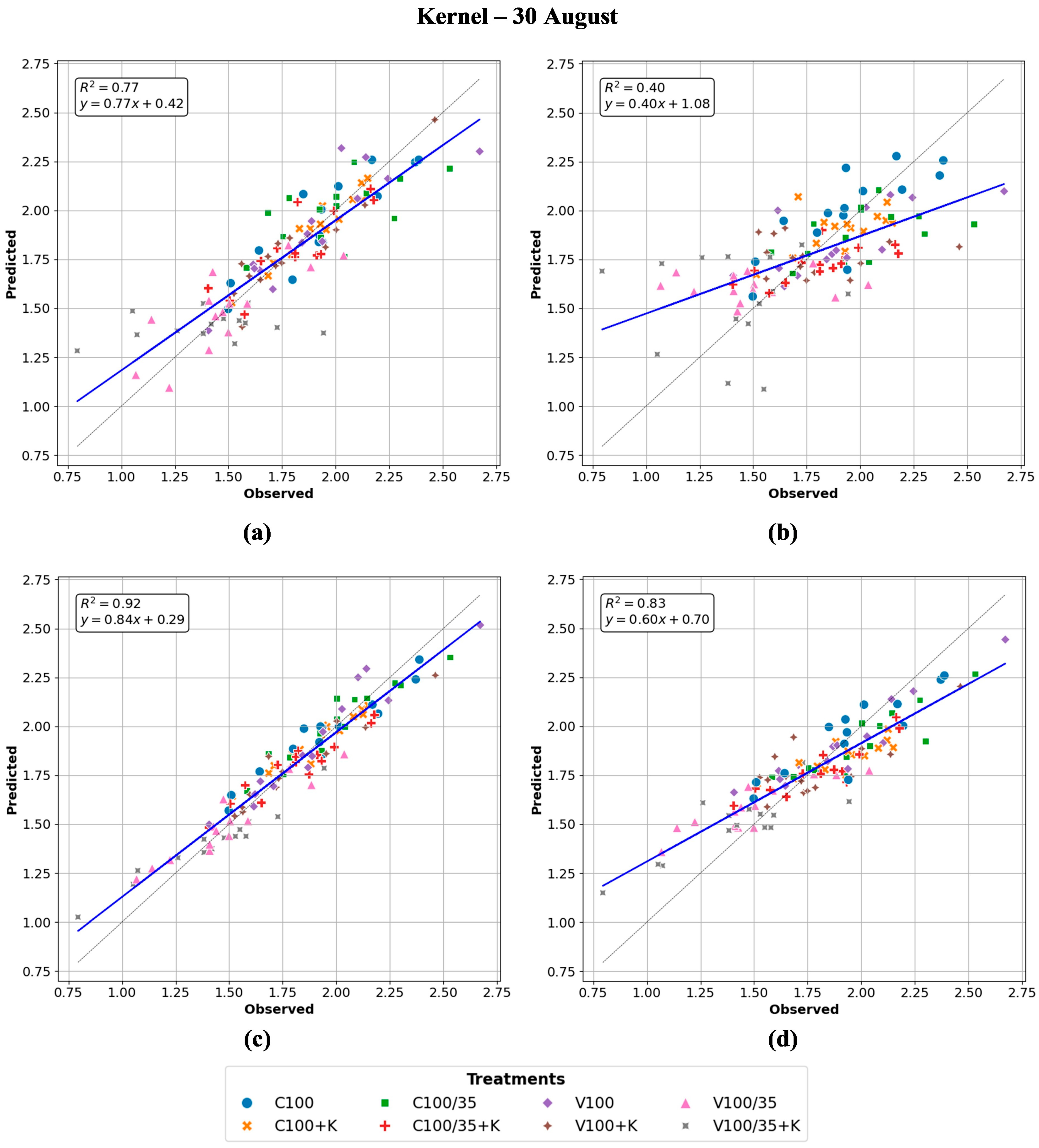
References
- Ladizinsky, G. On the origin of almond. Genet. Resour. Crop Evol. 1999, 46, 143–147. [Google Scholar] [CrossRef]
- Delplancke, M.; Alvarez, N.; Benoit, L.; Espíndola, A.; Joly, H.I.; Neuenschwander, S.; Arrigo, N. Evolutionary history of almond tree domestication in the Mediterranean basin. Mol. Ecol. 2013, 22, 1092–1104. [Google Scholar] [CrossRef]
- Lordan, J.; Zazurca, L.; Maldonado, M.; Torguet, L.; Alegre, S.; Miarnau, X. Horticultural performance of ‘Marinada’ and ‘Vairo’ almond cultivars grown on a genetically diverse set of rootstocks. Sci. Hortic. 2019, 256, 108558. [Google Scholar] [CrossRef]
- Gutiérrez-Gordillo, S.; Durán Zuazo, V.H.; Hernández-Santana, V.; Gil, F.F.; Escalera, A.G.; Amores-Agüera, J.J.; García-Tejero, I.F. Cultivar Dependent Impact on Yield and Its Components of Young Almond Trees under Sustained-Deficit Irrigation in Semi-Arid Environments. Agronomy 2020, 10, 733. [Google Scholar] [CrossRef]
- Fernandes de Oliveira, A.; Mameli, M.G.; De Pau, L.; Satta, D. Almond Tree Adaptation to Water Stress: Differences in Physiological Performance and Yield Responses among Four Cultivar Grown in Mediterranean Environment. Plants 2023, 12, 1131. [Google Scholar] [CrossRef] [PubMed]
- Freitas, T.R.; Santos, J.A.; Silva, A.P.; Fraga, H. Reviewing the Adverse Climate Change Impacts and Adaptation Measures on Almond Trees (Prunus dulcis). Agriculture 2023, 13, 1423. [Google Scholar] [CrossRef]
- García-Tejero, I.F.; Gutiérrez Gordillo, S.; Souza, L.; Cuadros-Tavira, S.; Durán Zuazo, V.H. Fostering sustainable water use in almond (Prunus dulcis Mill.) orchards in a semiarid Mediterranean environment. Arch. Agron. Soil Sci. 2019, 65, 164–181. [Google Scholar] [CrossRef]
- Lipan, L.; Cano-Lamadrid, M.; Hernández, F.; Sendra, E.; Corell, M.; Vázquez-Araújo, L.; Moriana, A.; Carbonell-Barrachina, Á.A. Long-Term Correlation between Water Deficit and Quality Markers in HydroSOStainable Almonds. Agronomy 2020, 10, 1470. [Google Scholar] [CrossRef]
- Monksa, D.P.; Taylor, C.; Sommer, K.; Treeby, M.T. Deficit irrigation of almond trees did not decrease Yield. Acta Hortic. 2017, 1150, 251–260. [Google Scholar] [CrossRef]
- López-López, M.; Espadador, M.; Testi, L.; Lorite, I.J.; Orgaz, F.; Fereres, E. Water use of irrigated almond trees when subjected to water deficits. Agric. Water Manag. 2018, 195, 84–93. [Google Scholar] [CrossRef]
- Stewart, W.L.; Fulton, A.E.; Krueger, W.H.; Lampinen, B.D.; Shackel, K.A. Regulated deficit irrigation reduces water use of almonds without affecting yield. Calif. Agric. 2011, 65, 90–95. [Google Scholar] [CrossRef]
- Alcon, F.; Egea, G.; Nortes, P.A. Financial feasibility of implementing regulated and sustained deficit irrigation in almond orchards. Irrig. Sci. 2013, 31, 931–941. [Google Scholar] [CrossRef]
- Yadollahi, A.; Arzani, K.; Ebadi, A.; Wirthensohn, M.; Karimi, S. The response of different almond genotypes to moderate and severe water stress in order to screen for drought tolerance. Sci. Hortic. 2011, 129, 403–413. [Google Scholar] [CrossRef]
- Mirás-Avalos, J.M.; Gonzalez-Dugo, V.; García-Tejero, I.F.; López-Urrea, R.; Intrigliolo, D.S.; Egea, G. Quantitative analysis of almond yield response to irrigation regimes in Mediterranean Spain. Agric. Water Manag. 2023, 279, 108208. [Google Scholar] [CrossRef]
- Prgomet, I.; Pascual-Seva, N.; Morais, M.C.; Aires, A.; Barreales, D.; Castro Ribeiro, A.; Silva, A.P.; Barros, A.I.R.N.A.; Gonçalves, B. Physiological and biochemical performance of almond trees under deficit irrigation. Sci. Hortic. 2020, 261, 108990. [Google Scholar] [CrossRef]
- Sperling, O.; Gardi, I.; Ben-Gal, A.; Kamai, T. Deficit irrigation limits almond trees’ photosynthetic productivity and compromises yields. Agric. Water Manag. 2023, 289, 108562. [Google Scholar] [CrossRef]
- Collin, G.; Caron, J.; Létourneau, G.; Gallichand, J. Yield and Water Use in Almond under Deficit Irrigation. Agron. J. 2019, 111, 1381–1391. [Google Scholar] [CrossRef]
- Brito, C.; Dinis, L.T.; Moutinho-Pereira, J.; Correia, C. Kaolin, an emerging tool to alleviate the effects of abiotic stresses on crop performance. Sci. Hortic. 2019, 250, 310–316. [Google Scholar] [CrossRef]
- Marcotegui, A.; Sánchez-Ramos, I.; Pascual, S.; Fernández, C.E.; Cobos, G.; Armendáriz, I.; Cobo, A.; González-Núñez, M. Kaolin and potassium soap with thyme essential oil to control Monosteira unicostata and other phytophagous arthropods of almond trees in organic orchards. J. Pest Sci. 2015, 88, 753–765. [Google Scholar] [CrossRef]
- Sánchez-Ramos, I.; Marcotegui, A.; Pascual, S.; Fernández, C.E.; Cobos, G.; González-Núñez, M. Compatibility of organic farming treatments against Monosteira unicostata with non-target arthropod fauna of almond trees canopy. Span. J. Agric. Res. 2017, 15, 2. [Google Scholar] [CrossRef]
- Modi, A.; Sharma, P.; Saraswat, D.; Mehta, R. Review of Crop Yield Estimation Using Machine Learning and Deep Learning Techniques. Scalable Comput. 2022, 23, 59–79. [Google Scholar] [CrossRef]
- Gade, S.A.; Madolli, M.J.; García-Caparrós, P.; Ullah, H.; Cha-um, S.; Datta, A.; Himanshu, S.K. Advancements in UAV remote sensing for agricultural yield estimation: A systematic comprehensive review of platforms, sensors, and data analytics. Remote Sens. Appl. Soc. Environ. 2025, 37, 101418. [Google Scholar] [CrossRef]
- Saravia, D.; Valqui-Valqui, L.; Salazar, W.; Quille-Mamani, J.; Barboza, E.; Porras-Jorge, R.; Injante, P.; Arbizu, C.I. Yield Prediction of Four Bean (Phaseolus vulgaris) Cultivars Using Vegetation Indices Based on Multispectral Images from UAV in an Arid Zone of Peru. Drones 2023, 7, 325. [Google Scholar] [CrossRef]
- Avneri, A.; Aharon, S.; Brook, A.; Atsmon, G.; Smirnov, E.; Sadeh, R.; Abbo, S.; Peleg, Z.; Herrmann, I.; Bonfil, D.J.; et al. UAS-based imaging for prediction of chickpea crop biophysical parameters and yield. Comput. Electron. Agric. 2023, 205, 107581. [Google Scholar] [CrossRef]
- Saravia, D.; Salazar, W.; Valqui-Valqui, L.; Quille-Mamani, J.; Porras-Jorge, R.; Corredor, F.A.; Barboza, E.; Vásquez, H.V.; Casas Diaz, A.V.; Arbizu, C.I. Yield Predictions of Four Hybrids of Maize (Zea mays) Using Multispectral Images Obtained from UAV in the Coast of Peru. Agronomy 2022, 12, 2630. [Google Scholar] [CrossRef]
- Silveira, C.; Almeida, A.; Ribeiro, A.C. Technological Innovation in the Traditional Olive Orchard Management: Advances and Opportunities to the Northeastern Region of Portugal. Water 2022, 14, 4081. [Google Scholar] [CrossRef]
- Panda, S.S.; Ames, D.P.; Panigrahi, S. Application of Vegetation Indices for Agricultural Crop Yield Prediction Using Neural Network Techniques. Remote Sens. 2010, 2, 673–696. [Google Scholar] [CrossRef]
- Ramos, A.P.M.; Prado Osco, L.; Elis Garcia Furuya, D.; Nunes Gonçalves, W.; Cordeiro Santana, D.; Pereira Ribeiro Teodoro, L.; Antonio da Silva Junior, C.; Fernando Capristo-Silva, G.; Li, J.; Henrique Rojo Baio, F.; et al. A random forest ranking approach to predict yield in maize with uav-based vegetation spectral indices. Comput. Electron. Agric. 2020, 178, 105791. [Google Scholar] [CrossRef]
- Killeen, P.; Kiringa, I.; Yeap, T.; Branco, P. Corn Grain Yield Prediction Using UAV-Based High Spatiotemporal Resolution Imagery, Machine Learning, and Spatial Cross-Validation. Remote Sens. 2024, 16, 683. [Google Scholar] [CrossRef]
- Han, X.; Wei, Z.; Chen, H.; Zhang, B.; Li, Y.; Du, T. Inversion of Winter Wheat Growth Parameters and Yield Under Different Water Treatments Based on UAV Multispectral Remote Sensing. Front. Plant Sci. 2021, 12, 609876. [Google Scholar] [CrossRef]
- Zhou, X.; Zheng, H.B.; Xu, X.Q.; He, J.Y.; Ge, X.K.; Yao, X.; Cheng, T.; Zhu, Y.; Cao, W.X.; Tian, Y.C. Predicting grain yield in rice using multi-temporal vegetation indices from UAV-based multispectral and digital imagery. ISPRS J. Photogramm. Remote Sens. 2017, 130, 246–255. [Google Scholar] [CrossRef]
- Guimarães, N.; Fraga, H.; Sousa, J.J.; Pádua, L.; Bento, A.; Couto, P. Comparative Evaluation of Remote Sensing Platforms for Almond Yield Prediction. AgriEngineering 2024, 6, 240–258. [Google Scholar] [CrossRef]
- Gutiérrez-Gordillo, S.; de la Gala González-Santiago, J.; Trigo-Córdoba, E.; Rubio-Casal, A.E.; García-Tejero, I.F.; Egea, G. Monitoring of Emerging Water Stress Situations by Thermal and Vegetation Indices in Different Almond Cultivars. Agronomy 2021, 11, 1419. [Google Scholar] [CrossRef]
- Sarkar, T.K.; Roy, D.K.; Kang, Y.S.; Jun, S.R.; Park, J.W.; Ryu, C.S. Ensemble of Machine Learning Algorithms for Rice Grain Yield Prediction Using UAV-Based Remote Sensing. J. Biosyst. Eng. 2024, 49, 1–19. [Google Scholar] [CrossRef]
- Feng, L.; Zhang, Z.; Ma, Y.; Du, Q.; Williams, P.; Drewry, J.; Luck, B. Alfalfa yield prediction using UAV-based hyperspectral imagery and ensemble learning. Remote Sens. 2020, 12, 2028. [Google Scholar] [CrossRef]
- Fu, Z.; Jiang, J.; Gao, Y.; Krienke, B.; Wang, M.; Zhong, K.; Cao, Q.; Tian, Y.; Zhu, Y.; Cao, W.; et al. Wheat growth monitoring and yield estimation based on multi-rotor unmanned aerial vehicle. Remote Sens. 2020, 12, 508. [Google Scholar] [CrossRef]
- Canata, T.F.; Wei, M.C.F.; Maldaner, L.F.; Molin, J.P. Sugarcane yield mapping using high-resolution imagery data and machine learning technique. Remote Sens. 2021, 13, 232. [Google Scholar] [CrossRef]
- Martello, M.; Molin, J.P.; Wei, M.C.F.; Canal Filho, R.; Nicoletti, J.V.M. Coffee-Yield Estimation Using High-Resolution Time-Series Satellite Images and Machine Learning. AgriEngineering 2022, 4, 888–902. [Google Scholar] [CrossRef]
- Silveira, C.; Almeida, A.; Ribeiro, A.C. How Can a Changing Climate Influence the Productivity of Traditional Olive Orchards? Regression Analysis Applied to a Local Case Study in Portugal. Climate 2023, 11, 123. [Google Scholar] [CrossRef]
- Maseko, S.; van der Laan, M.; Tesfamariam, E.H.; Delport, M.; Otterman, H. Evaluating machine learning models and identifying key factors influencing spatial maize yield predictions in data intensive farm management. Eur. J. Agron. 2024, 157, 127193. [Google Scholar] [CrossRef]
- Baio, F.H.R.; Santana, D.C.; Teodoro, L.P.R.; de Oliveira, I.C.; Gava, R.; de Oliveira, J.L.G.; da Silva Junior, C.A.; Teodoro, P.E.; Shiratsuchi, L.S. Maize Yield Prediction with Machine Learning, Spectral Variables and Irrigation Management. Remote Sens. 2023, 15, 79. [Google Scholar] [CrossRef]
- Kpienbaareh, D.; Mohammed, K.; Luginaah, I.; Wang, J.; Bezner Kerr, R.; Lupafya, E.; Dakishoni, L. Estimating Groundnut Yield in Smallholder Agriculture Systems Using PlanetScope Data. Land 2022, 11, 1752. [Google Scholar] [CrossRef]
- Jhajharia, K.; Mathur, P. Prediction of crop yield using satellite vegetation indices combined with machine learning approaches. Adv. Space Res. 2023, 72, 3998–4007. [Google Scholar] [CrossRef]
- Shammi, S.A.; Huang, Y.; Feng, G.; Tewolde, H.; Zhang, X.; Jenkins, J.; Shankle, M. Application of UAV Multispectral Imaging to Monitor Soybean Growth with Yield Prediction through Machine Learning. Agronomy 2024, 14, 672. [Google Scholar] [CrossRef]
- Maimaitijiang, M.; Sagan, V.; Sidike, P.; Hartling, S.; Esposito, F.; Fritschi, F.B. Soybean yield prediction from UAV using multimodal data fusion and deep learning. Remote Sens. Environ. 2020, 237, 111599. [Google Scholar] [CrossRef]
- İrik, H.A.; Ropelewska, E.; Çetin, N. Using spectral vegetation indices and machine learning models for predicting the yield of sugar beet (Beta vulgaris L.) under different irrigation treatments. Comput. Electron. Agric. 2024, 221, 109019. [Google Scholar] [CrossRef]
- Elsayed, S.; El-Hendawy, S.; Dewir, Y.H.; Schmidhalter, U.; Ibrahim, H.H.; Ibrahim, M.M.; Elsherbiny, O.; Farouk, M. Estimating the leaf water status and grain yield of wheat under different irrigation regimes using optimized two-and three-band hyperspectral indices and multivariate regression models. Water 2021, 13, 2666. [Google Scholar] [CrossRef]
- Van Huu, B.; Quang Hieu, N.; Trong Hieu, L. Monitoring growth and predicting crop yield through UAV-mounted spectral camera analysis of the interplay between soil compaction and vegetation index. Emir. J. Food Agric. 2024, 36, 1–10. [Google Scholar] [CrossRef]
- Guo, Y.; Fu, Y.H.; Chen, S.; Hao, F.; Zhang, X.; de Beurs, K.; He, Y. Predicting grain yield of maize using a new multispectral-based canopy volumetric vegetation index. Ecol. Indic. 2024, 166, 112295. [Google Scholar] [CrossRef]
- Peralta, N.R.; Assefa, Y.; Du, J.; Barden, C.J.; Ciampitti, I.A. Mid-season high-resolution satellite imagery for forecasting site-specific corn yield. Remote Sens. 2016, 8, 848. [Google Scholar] [CrossRef]
- Du, M.; Noguchi, N. Monitoring of wheat growth status and mapping of wheat yield’s within-field spatial variations using color images acquired from UAV-camera System. Remote Sens. 2017, 9, 289. [Google Scholar] [CrossRef]
- Pang, A.; Chang, M.W.L.; Chen, Y. Evaluation of Random Forests (RF) for Regional and Local-Scale Wheat Yield Prediction in Southeast Australia. Sensors 2022, 22, 717. [Google Scholar] [CrossRef]
- Shanmugapriya, P.; Latha, K.R.; Pazhanivelan, S.; Kumaraperumal, R.; Karthikeyan, G.; Sudarmanian, N.S. Cotton yield prediction using drone derived LAI and chlorophyll content. J. Agrometeorol. 2022, 24, 348–352. [Google Scholar] [CrossRef]
- Peel, M.C.; Finlayson, B.L.; McMahon, T.A. Updated world map of the Köppen-Geiger climate classification. Hydrol. Earth Syst. Sci. 2007, 11, 1633–1644. [Google Scholar] [CrossRef]
- Coba Agroconsultores Soil Map, Current Land Use Map and Land Suitability Map of the Northeast of Portugal. 1991.
- Barreales, D.; Pereira, J.A.; Casal, S.; Ribeiro, A.C. Influence of sustained deficit irrigation and foliar kaolin application on almond kernel composition. Sci. Hortic. 2023, 321, 112262. [Google Scholar] [CrossRef]
- Barreales, D.; Fernandes, Â.; Barros, L.; Capitão, S.; Castro Ribeiro, A. Effects of regulated deficit irrigation and foliar kaolin application on quality parameters of almond [Prunus dulcis (Mill.) D.A. Webb]. J. Sci. Food Agric. 2023, 103, 7227–7240. [Google Scholar] [CrossRef] [PubMed]
- Barreales, D.; Capitão, S.; Bento, A.A.; Casquero, P.A.; Ribeiro, A.C. Adapting Almond Production to Climate Change through Deficit Irrigation and Foliar Kaolin Application in a Mediterranean Climate. Atmosphere 2023, 14, 1593. [Google Scholar] [CrossRef]
- Allen, R.G.; Pereira, L.S.; Raes, D.; Smith, M. Crop Evapotranspiration-Guidelines for Computing Crop Water Requirements-FAO Irrigation and Drainage Paper 56; FAO: Rome, Italy, 1998. [Google Scholar]
- DJI Support for Matrice 300 RTK. Available online: https://www.dji.com/pt/matrice-300 (accessed on 30 January 2025).
- MicaSense RedEdge-MX Integration Guide. Available online: https://support.micasense.com/hc/en-us/articles/360011389334-RedEdge-MX-Integration-Guide (accessed on 30 January 2025).
- Agisoft Agisoft Metashape: Professional Edition. Available online: https://www.agisoft.com/features/professional-edition/ (accessed on 30 January 2025).
- Chen, J.M. Evaluation of Vegetation Indices and a Modified Simple Ratio for Boreal Applications. Can. J. Remote Sens. 1996, 22, 229–242. [Google Scholar] [CrossRef]
- Huete, A.; Didan, K.; Miura, T.; Rodriguez, E.P.; Gao, X.; Ferreira, L.G. Overview of the radiometric and biophysical performance of the MODIS vegetation indices. Remote Sens. Environ. 2002, 83, 195–213. [Google Scholar] [CrossRef]
- Gitelson, A.A.; Merzlyak, M.N. Remote sensing of chlorophyll concentration in higher plant leaves. Adv. Space Res. 1998, 22, 689–692. [Google Scholar] [CrossRef]
- Jorge, J.; Vallbé, M.; Soler, J.A. Detection of irrigation inhomogeneities in an olive grove using the NDRE vegetation index obtained from UAV images. Eur. J. Remote Sens. 2019, 52, 169–177. [Google Scholar] [CrossRef]
- Rondeaux, G.; Steven, M.; Baret, F. Optimization of soil-adjusted vegetation indices. Remote Sens. Environ. 1996, 55, 95–107. [Google Scholar] [CrossRef]
- Steven, M.D. The Sensitivity of the OSAVI Vegetation Index to Observational Parameters. Remote Sens. Environ. 1998, 63, 49–60. [Google Scholar] [CrossRef]
- Gitelson, A.A.; Stark, R.; Grits, U.; Rundquist, D.; Kaufman, Y.; Derry, D. Vegetation and soil lines in visible spectral space: A concept and technique for remote estimation of vegetation fraction. Int. J. Remote Sens. 2002, 23, 2537–2562. [Google Scholar] [CrossRef]
- Biudes, M.S.; Machado, N.G.; de Morais Danelichen, V.H.; Souza, M.C.; Vourlitis, G.L.; de Souza Nogueira, J. Ground and remote sensing-based measurements of leaf area index in a transitional forest and seasonal flooded forest in Brazil. Int. J. Biometeorol. 2014, 58, 1181–1193. [Google Scholar] [CrossRef]
- Huete, A.R. A soil-adjusted vegetation index (SAVI). Remote Sens. Environ. 1988, 25, 295–309. [Google Scholar] [CrossRef]
- Lane, D.M. Introduction to Analysis of Variance. Available online: https://onlinestatbook.com/2/analysis_of_variance/intro.html (accessed on 10 March 2025).
- Scikit-Learn. Recursive Feature Elimination with Cross-Validation to Select Features. Available online: https://scikit-learn.org/stable/modules/generated/sklearn.feature_selection.RFECV.html (accessed on 10 March 2025).
- Scikit-Learn. Ordinary Least Squares Linear Regression. Available online: https://scikit-learn.org/stable/modules/generated/sklearn.linear_model.LinearRegression.html (accessed on 10 March 2025).
- Scikit-Learn. A Random Forest Regressor. Available online: https://scikit-learn.org/stable/modules/generated/sklearn.ensemble.RandomForestRegressor.html (accessed on 10 March 2025).
- Rosati, A.; Metcalf, S.G.; Buchner, R.P.; Fulton, A.E.; Lampinen, B.D. Physiological Effects of Kaolin Applications in Well-irrigated and Water-stressed Walnut and Almond Trees. Ann. Bot. 2006, 98, 267–275. [Google Scholar] [CrossRef]
- Gharaghani, A.; Javarzari, A.M.; Rezaei, A.; Nejati, R. Kaolin Spray Improves Growth, Physiological Functions, Yield, and Nut Quality of ‘Tardy Nonpareil’ Almond Under Deficit Irrigation Regimens. Erwerbs-Obstbau 2022, 65, 989–1001. [Google Scholar] [CrossRef]
- Segura-Monroy, S.; Uribe-Vallejo, A.; Ramírez-Godoy, A.; Restrepo-Díaz, H. Effect of Kaolin Application on Growth, Water Use Efficiency, and Leaf Epidermis Characteristics of Physalis peruviana L. Seedlings under Two Irrigation Regimes. J. Agric. Sci. Technol. 2015, 17, 1585–1596. [Google Scholar]
- Brito, C.; Gonçalves, A.; Silva, E.; Martins, S.; Pinto, L.; Rocha, L.; Arrobas, M.; Rodrigues, M.Â.; Moutinho-Pereira, J.; Correia, C.M. Kaolin foliar spray improves olive tree performance and yield under sustained deficit irrigation. Sci. Hortic. 2021, 277, 109795. [Google Scholar] [CrossRef]
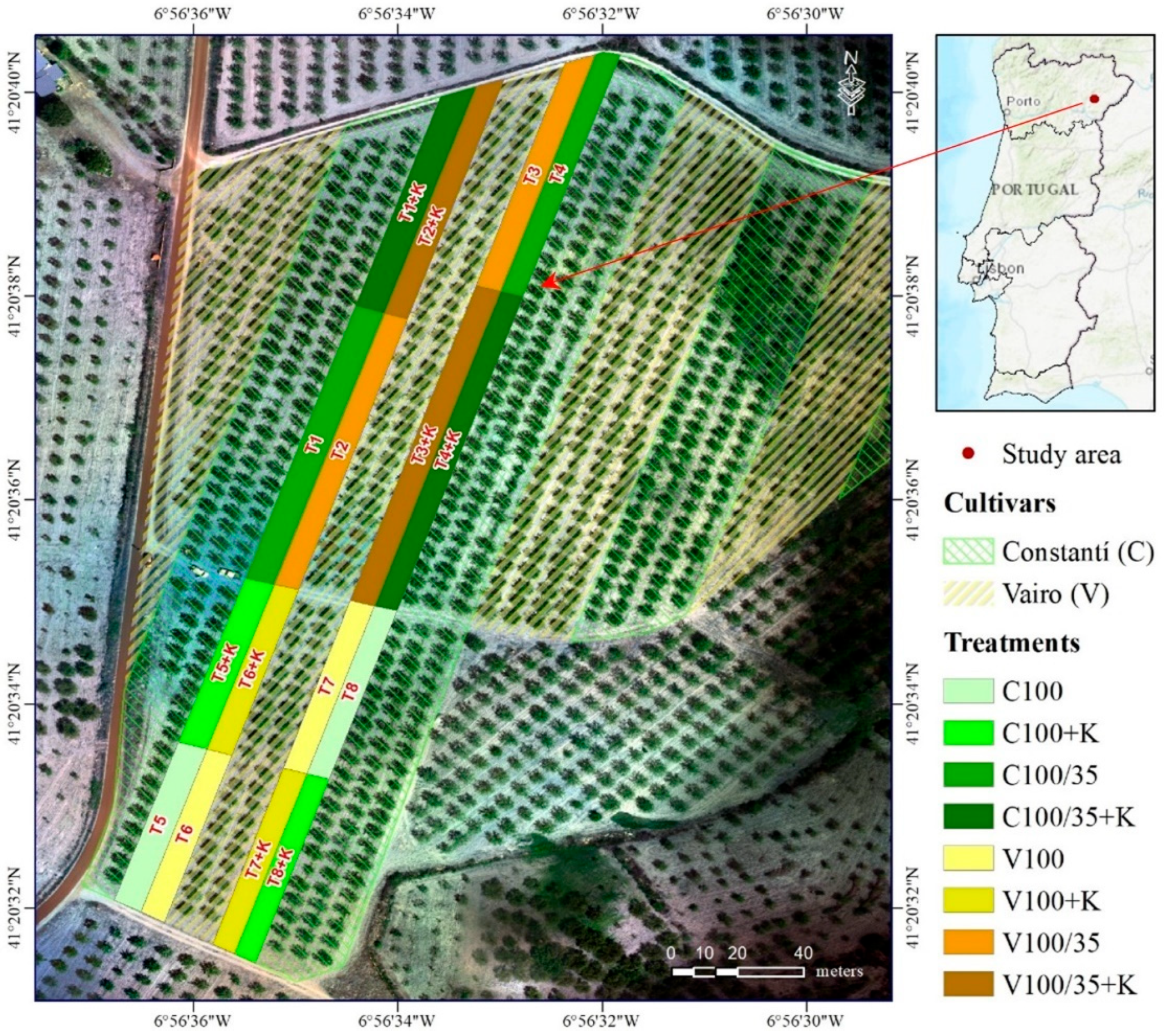
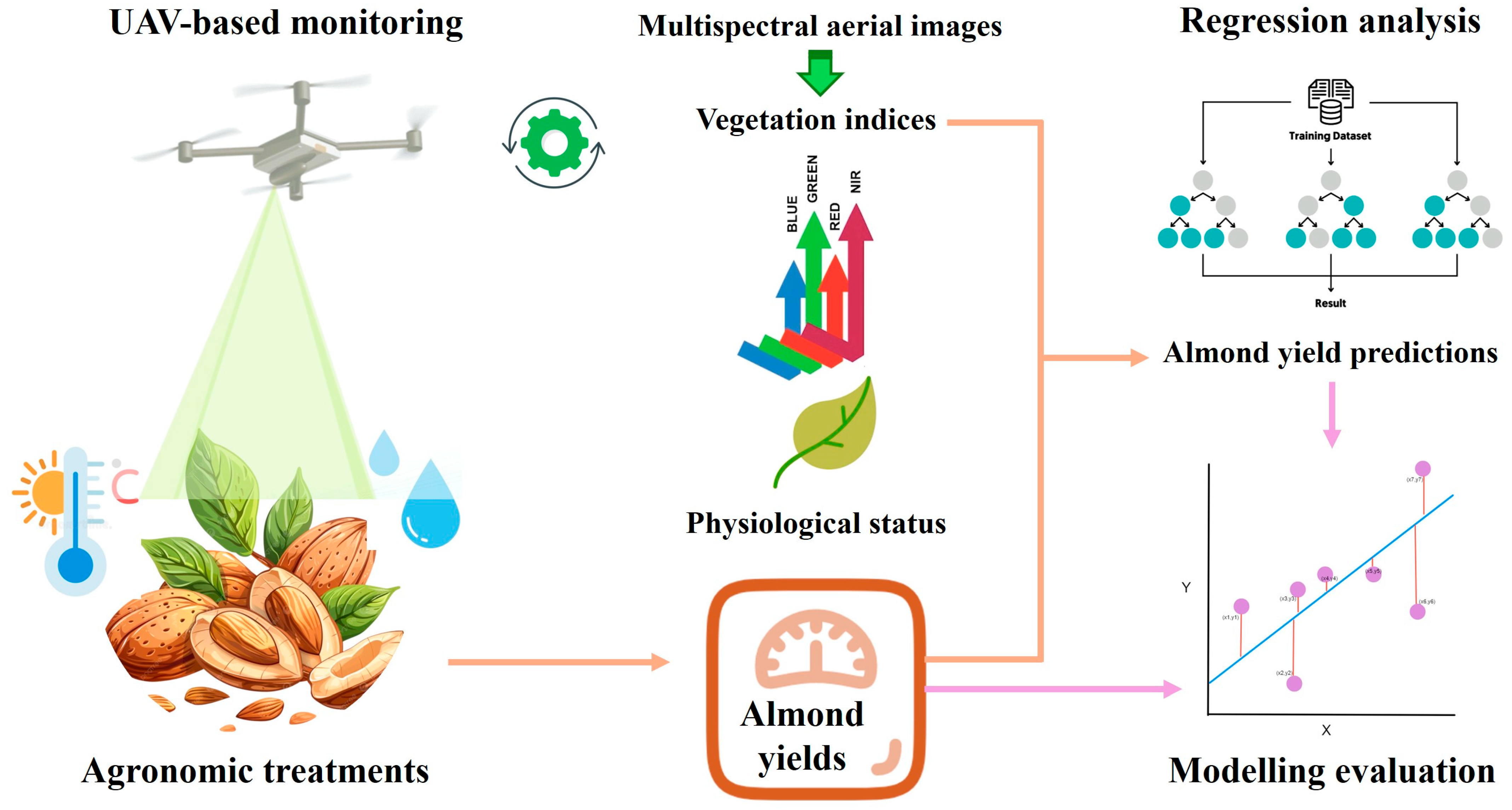
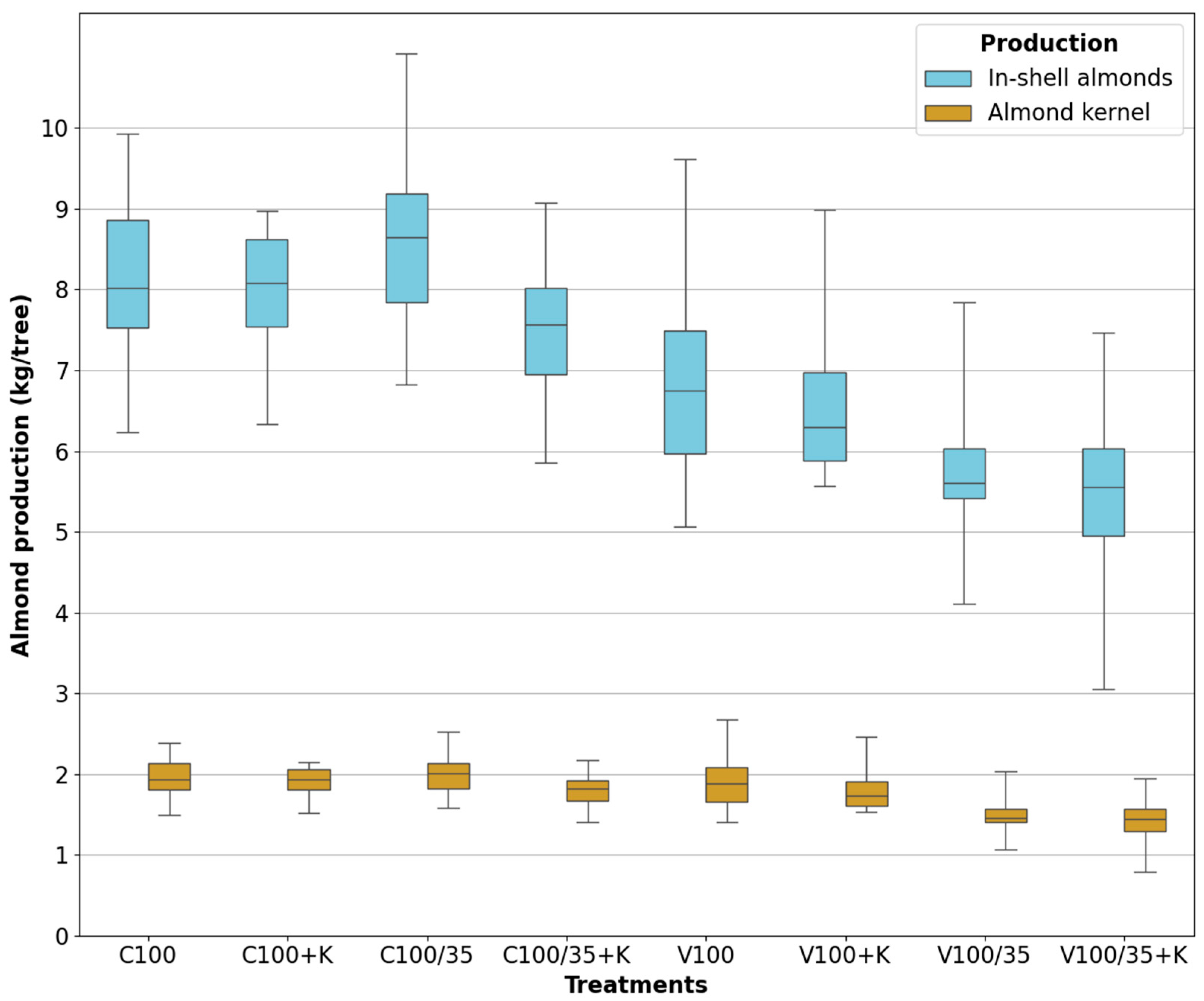
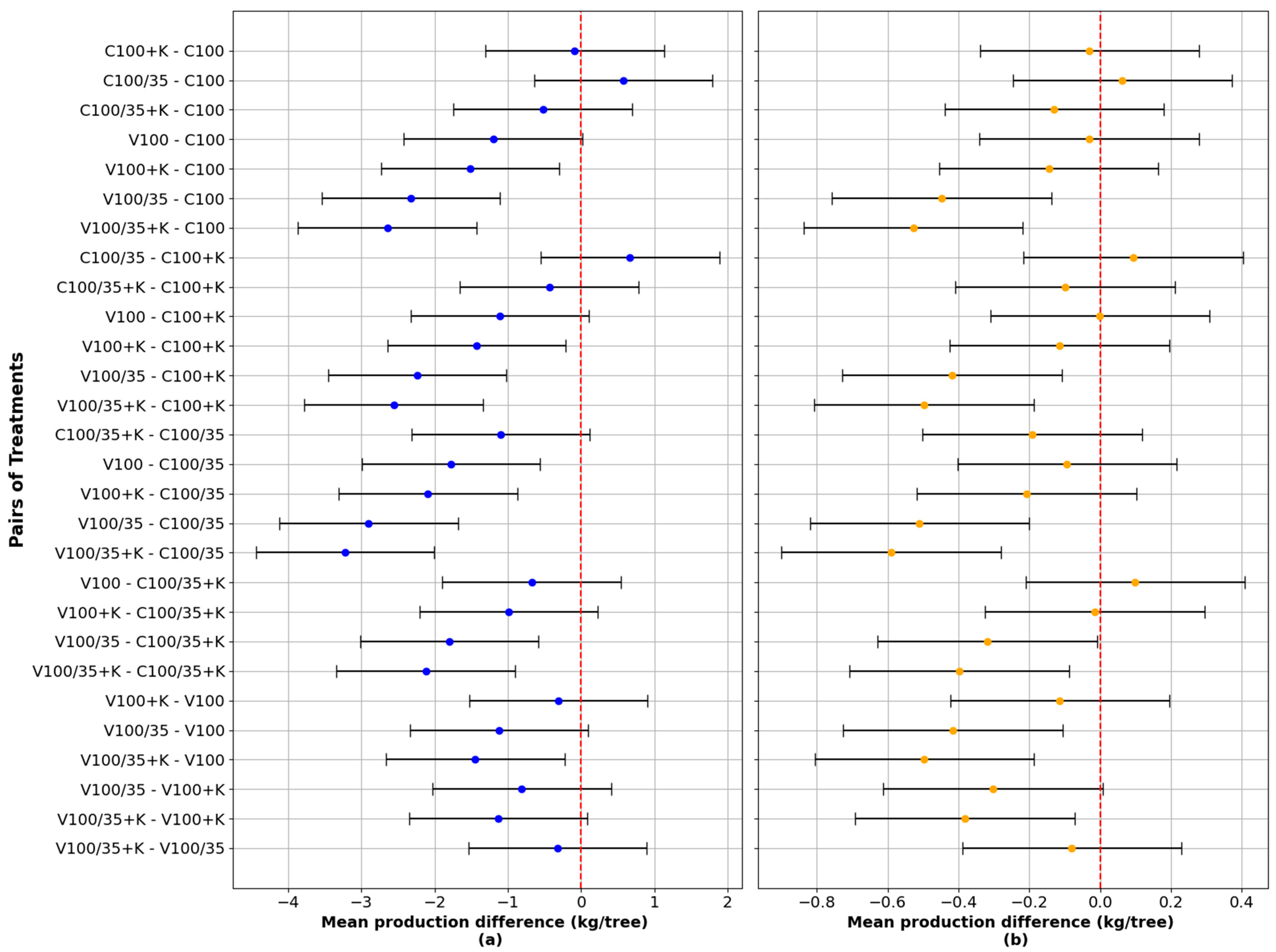
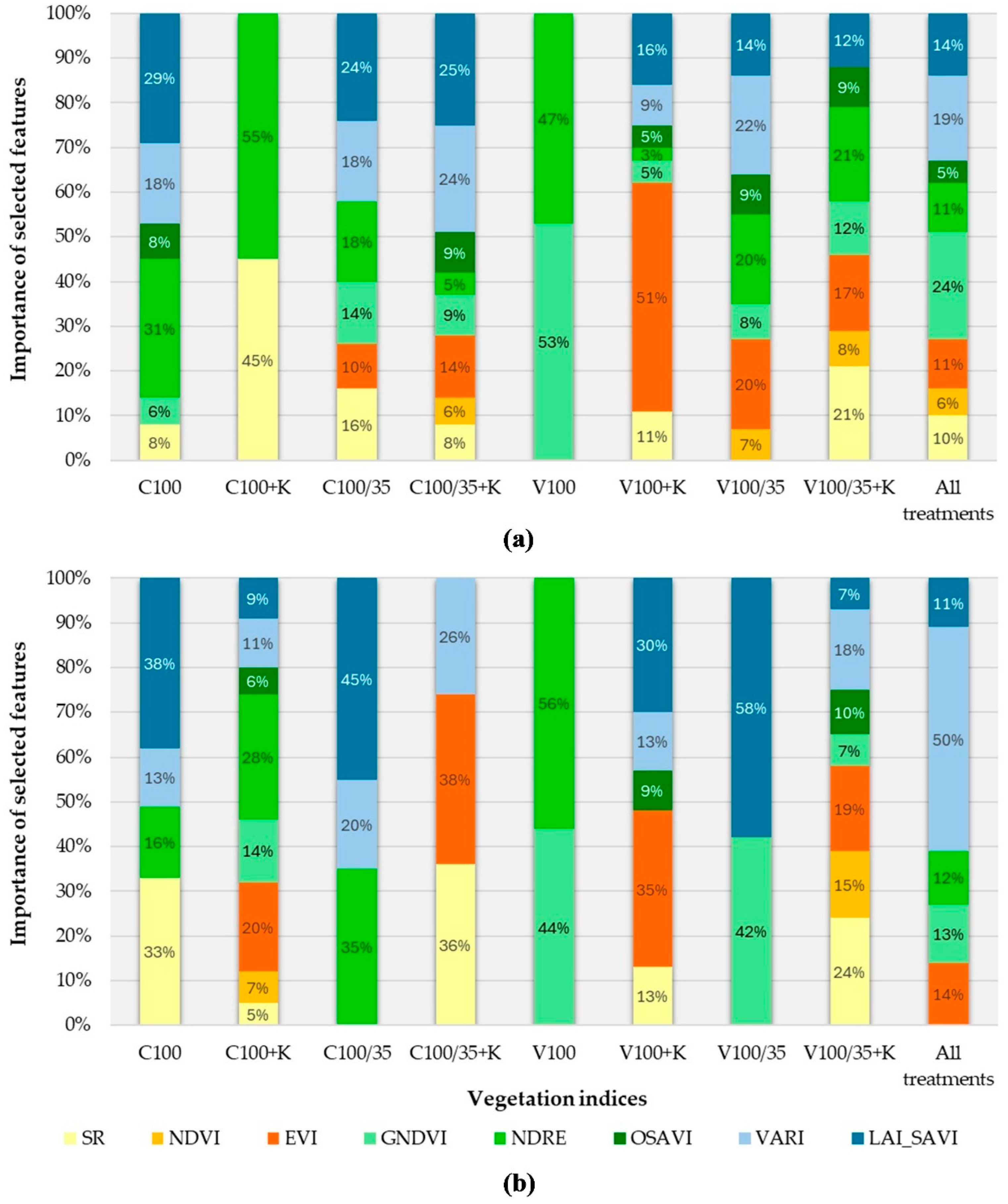
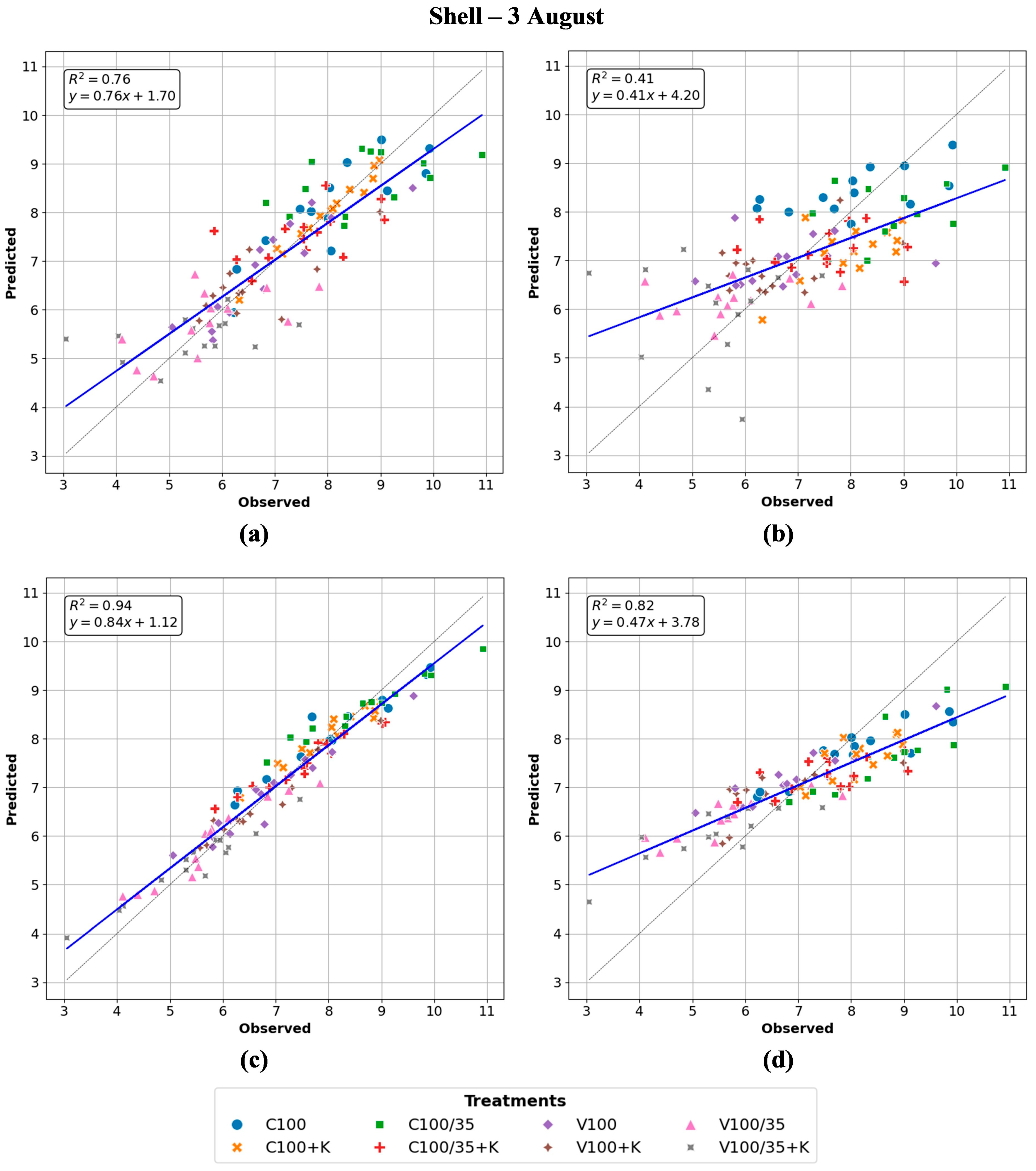

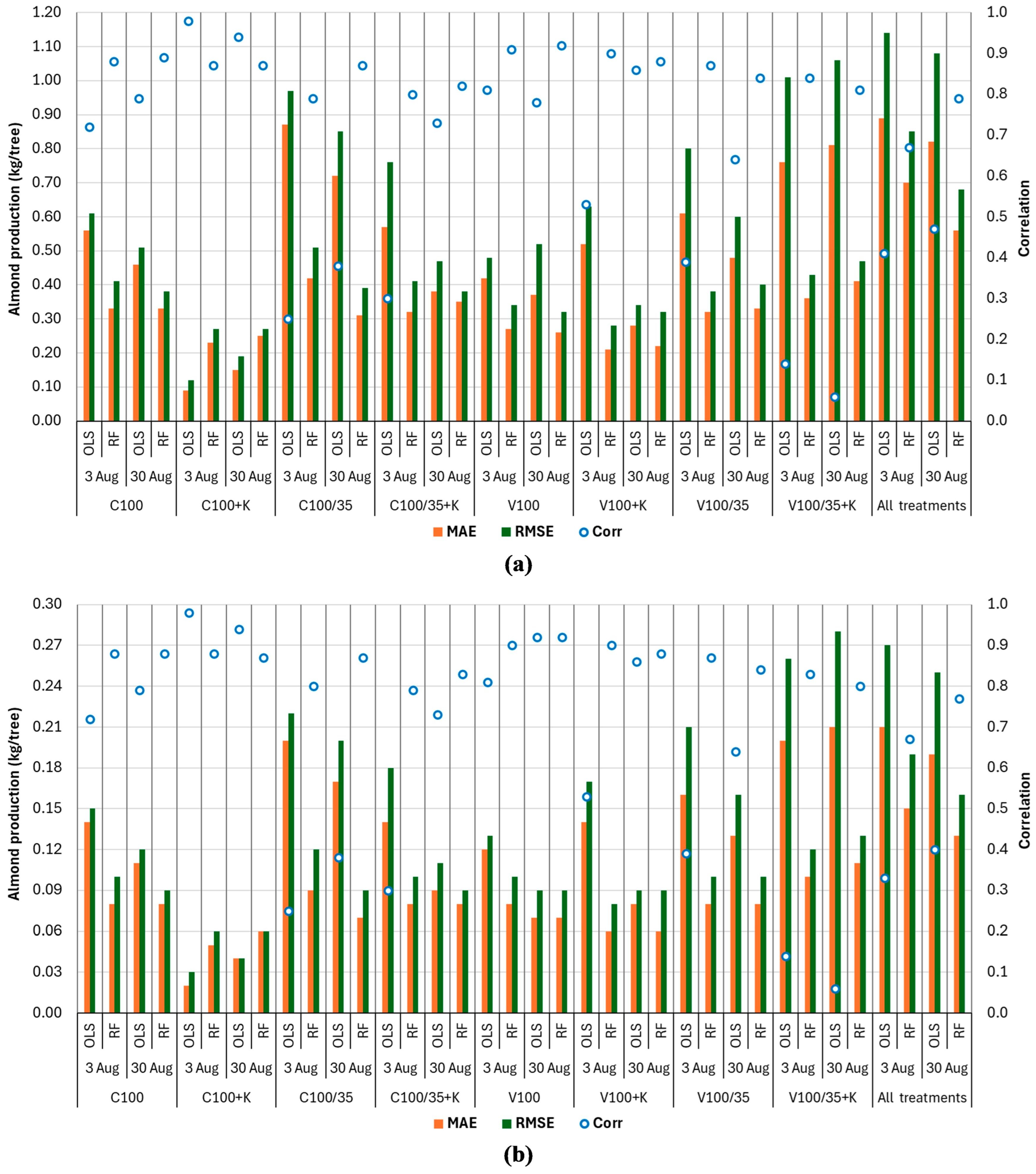
| Treatments | Factors | Experimental Plots | ||
|---|---|---|---|---|
| Cultivar | Irrigation | Kaolin | ||
| C100 | Constantí | FI | No | T5, T8 |
| C100+K | Constantí | FI | Yes | T5 + K, T8 + K |
| C100/35 | Constantí | RDI | No | T1, T4 |
| C100/35+K | Constantí | RDI | Yes | T1 + K, T4 + K |
| V100 | Vairo | FI | No | T6, T7 |
| V100+K | Vairo | FI | Yes | T6 + K, T7 + K |
| V100/35 | Vairo | RDI | No | T2, T3 |
| V100/35+K | Vairo | RDI | Yes | T2 + K, T3 + K |
| Vegetation Indices | Formula | Description |
|---|---|---|
| Simple Ratio | It is used to estimate the relative biomass. Higher values are associated with a large LAI [63]. | |
| Normalised Difference Vegetation Index | Classic and effective indicator in a first crop physiological assessment, used for monitoring the percentage of green cover throughout the growth season. Values close to 1 are indicative of healthier and dense vegetation [64]. | |
| Enhanced Vegetation Index | It was developed to optimise the vegetation signal in areas with a high LAI, where NDVI can be saturated [64]. | |
| Green Normalised Difference Vegetation Index | It is a chlorophyll index used in advanced crop development stages, as it saturates later than NDVI [65]. | |
| Normalised Difference Red Edge | Index similar to the NDVI, but more sensitive to high canopy density and leaf chlorophyll levels and in capturing soil background effects [66]. | |
| Optimised Soil-Adjusted Vegetation Index | It is an extension of the Soil-Adjusted Vegetation Index (SAVI), which includes an optimised soil adjustment coefficient (0.16) to minimise the NDVI sensitivity due to variations in soil background effects under a wide range of environmental conditions [67,68]. | |
| Visible Atmospherically Resistant Index | It is derived from visible spectral bands to provide more accurate measurements of the vegetation fraction by reducing atmospheric scattering and absorption effects [69]. | |
| SAVI-based Leaf Area Index 1 | SAVI used as a proxy to estimate LAI [70]. SAVI was developed to minimise the influence of soil brightness on plant monitoring, especially in areas with sparse vegetation cover [71]. |
| Factors | Production Type | SS 1 | F 2 | p-Value 3 |
|---|---|---|---|---|
| Treatments | Shell | 130.3610 | 17.1555 | 0.0000 |
| Kernel | 4.5904 | 9.3451 | 0.0000 | |
| C | Shell | 102.5307 | 94.4511 | 0.0000 |
| Kernel | 1.9477 | 27.7560 | 0.0000 | |
| I | Shell | 7.8195 | 7.2033 | 0.0085 |
| Kernel | 1.2244 | 17.4485 | 0.0001 | |
| K | Shell | 5.8215 | 5.3628 | 0.0225 |
| Kernel | 0.3034 | 4.3241 | 0.0400 | |
| C * I | Shell | 10.0647 | 9.2716 | 0.0029 |
| Kernel | 1.0172 | 14.4960 | 0.0002 | |
| C * K | Shell | 0.5390 | 0.4965 | 0.4826 |
| Kernel | 0.0014 | 0.0204 | 0.8867 | |
| I * K | Shell | 1.8218 | 1.6782 | 0.1980 |
| Kernel | 0.0287 | 0.4096 | 0.5236 | |
| C * I * K | Shell | 1.7638 | 1.6248 | 0.2053 |
| Kernel | 0.0674 | 0.9610 | 0.3292 |
Disclaimer/Publisher’s Note: The statements, opinions and data contained in all publications are solely those of the individual author(s) and contributor(s) and not of MDPI and/or the editor(s). MDPI and/or the editor(s) disclaim responsibility for any injury to people or property resulting from any ideas, methods, instructions or products referred to in the content. |
© 2025 by the authors. Licensee MDPI, Basel, Switzerland. This article is an open access article distributed under the terms and conditions of the Creative Commons Attribution (CC BY) license (https://creativecommons.org/licenses/by/4.0/).
Share and Cite
Silveira, C.; Barreales, D.; Castro, J.P.; Miranda, F.; Ribeiro, A.C. Assessing the Impact of Deficit Irrigation and Kaolin Application on Almond Orchards: Statistical Relationships with Crop Yields and Spectral Vegetation Indices. AgriEngineering 2025, 7, 395. https://doi.org/10.3390/agriengineering7110395
Silveira C, Barreales D, Castro JP, Miranda F, Ribeiro AC. Assessing the Impact of Deficit Irrigation and Kaolin Application on Almond Orchards: Statistical Relationships with Crop Yields and Spectral Vegetation Indices. AgriEngineering. 2025; 7(11):395. https://doi.org/10.3390/agriengineering7110395
Chicago/Turabian StyleSilveira, Carlos, David Barreales, João P. Castro, Fabiani Miranda, and António C. Ribeiro. 2025. "Assessing the Impact of Deficit Irrigation and Kaolin Application on Almond Orchards: Statistical Relationships with Crop Yields and Spectral Vegetation Indices" AgriEngineering 7, no. 11: 395. https://doi.org/10.3390/agriengineering7110395
APA StyleSilveira, C., Barreales, D., Castro, J. P., Miranda, F., & Ribeiro, A. C. (2025). Assessing the Impact of Deficit Irrigation and Kaolin Application on Almond Orchards: Statistical Relationships with Crop Yields and Spectral Vegetation Indices. AgriEngineering, 7(11), 395. https://doi.org/10.3390/agriengineering7110395









